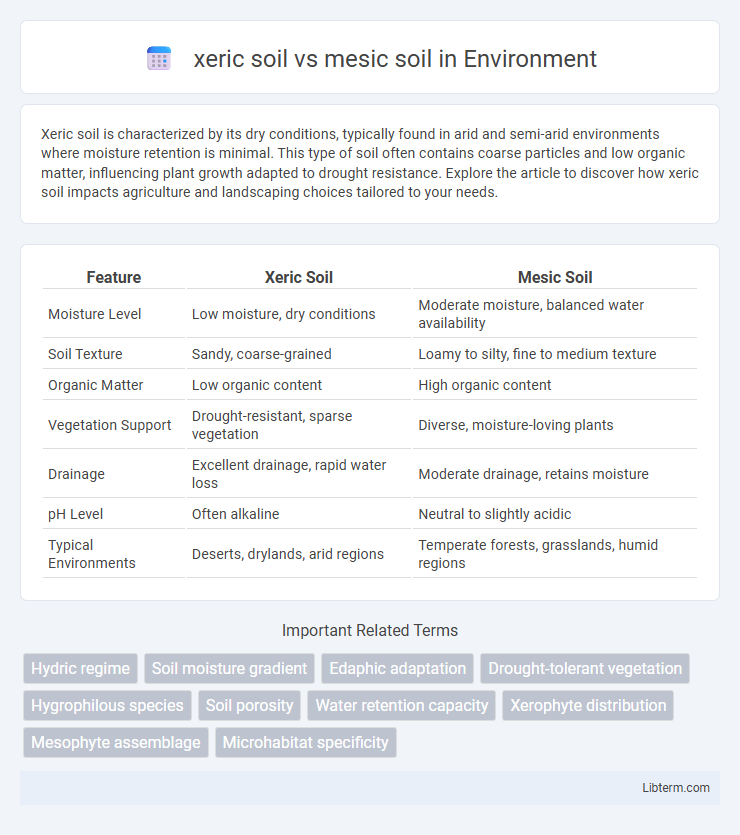Xeric soil is characterized by its dry conditions, typically found in arid and semi-arid environments where moisture retention is minimal. This type of soil often contains coarse particles and low organic matter, influencing plant growth adapted to drought resistance. Explore the article to discover how xeric soil impacts agriculture and landscaping choices tailored to your needs.
Table of Comparison
| Feature | Xeric Soil | Mesic Soil |
|---|---|---|
| Moisture Level | Low moisture, dry conditions | Moderate moisture, balanced water availability |
| Soil Texture | Sandy, coarse-grained | Loamy to silty, fine to medium texture |
| Organic Matter | Low organic content | High organic content |
| Vegetation Support | Drought-resistant, sparse vegetation | Diverse, moisture-loving plants |
| Drainage | Excellent drainage, rapid water loss | Moderate drainage, retains moisture |
| pH Level | Often alkaline | Neutral to slightly acidic |
| Typical Environments | Deserts, drylands, arid regions | Temperate forests, grasslands, humid regions |
Introduction to Xeric and Mesic Soils
Xeric soil is characterized by low moisture content and typically supports drought-tolerant vegetation, commonly found in arid or semi-arid regions. In contrast, mesic soil maintains moderate moisture levels, fostering diverse plant communities in temperate climates with balanced rainfall. Understanding the physical and chemical properties of xeric and mesic soils is essential for agricultural management and ecological restoration efforts.
Defining Xeric Soils: Key Characteristics
Xeric soils are characterized by limited moisture retention, typically found in arid or semi-arid regions where water availability is scarce. These soils often exhibit coarse texture, high mineral content, and low organic matter, which contribute to their poor water-holding capacity. Unlike mesic soils that maintain moderate moisture levels and support diverse vegetation, xeric soils demand drought-resistant plant species adapted to extreme dryness and nutrient-poor conditions.
Defining Mesic Soils: Key Characteristics
Mesic soils maintain moderate moisture levels, supporting diverse plant communities by balancing water retention and drainage. They typically exhibit well-developed horizons with organic matter-rich topsoil and stable structure, fostering nutrient availability. These soils are commonly found in temperate regions with consistent precipitation, promoting robust biological activity and soil fertility.
Climate and Environmental Influence
Xeric soils form in dry, arid climates with low precipitation, promoting drought-resistant vegetation and limiting microbial activity due to moisture scarcity. Mesic soils develop in moderate moisture environments characterized by balanced rainfall and temperature, supporting diverse plant communities and enhanced nutrient cycling. Climate-driven factors such as temperature fluctuations, humidity, and rainfall patterns critically influence soil moisture regimes, organic matter decomposition, and overall soil fertility in both xeric and mesic environments.
Soil Structure and Composition Comparison
Xeric soil typically features coarse particles, low organic matter, and high sand content, resulting in rapid drainage and limited water retention. Mesic soil contains finer particles, higher organic content, and balanced sand, silt, and clay proportions, promoting nutrient availability and moisture retention. The contrasting soil structures influence plant adaptation, with xeric soils favoring drought-resistant vegetation and mesic soils supporting diverse, moisture-dependent ecosystems.
Water Retention and Moisture Levels
Xeric soil is characterized by low water retention and minimal moisture levels, making it ideal for drought-tolerant plants and environments with infrequent rainfall. Mesic soil maintains moderate to high moisture levels with greater water retention capacity, supporting a wide variety of plant species requiring consistent hydration. Differences in organic matter content and soil texture primarily influence the contrast in moisture availability between xeric and mesic soil types.
Plant Adaptations in Xeric vs Mesic Soils
Plants in xeric soils exhibit adaptations such as deep root systems, thick cuticles, and reduced leaf surface area to conserve water in arid conditions. In contrast, mesic soil plants typically have broader leaves and shallower roots to maximize nutrient and water uptake in moderate moisture environments. These distinct adaptations enable species to thrive by optimizing resource use according to the soil moisture availability.
Ecosystem Biodiversity Differences
Xeric soils, characterized by low moisture and high drainage, support drought-tolerant plant species adapted to arid conditions, resulting in ecosystems with specialized, less diverse flora and fauna. Mesic soils maintain moderate moisture levels that sustain a wider range of plant communities, fostering higher biodiversity and more complex food webs. Consequently, mesic ecosystems often exhibit greater species richness and structural diversity compared to the more functionally specialized and limited biodiversity of xeric environments.
Human Use and Agricultural Suitability
Xeric soils, characterized by low moisture content and limited nutrient availability, are less suitable for conventional agriculture without significant irrigation and soil amendments, but they support drought-resistant crops like certain grains and succulents. Mesic soils maintain moderate moisture levels and fertility, making them ideal for a wide range of crops, including vegetables, fruits, and grains, thereby supporting intensive farming practices. Human use of xeric soils often involves grazing, forestry, and low-input agriculture, whereas mesic soils favor high-yield agriculture and diversified crop production.
Conclusion: Choosing the Right Soil for Sustainable Land Use
Selecting xeric soil supports sustainable land use in arid regions due to its excellent drainage and low moisture retention, preventing waterlogging and promoting drought-resistant vegetation. Mesic soil, with its moderate moisture and nutrient availability, is ideal for areas requiring balanced hydration and fertility to sustain diverse plant communities. Prioritizing the appropriate soil type enhances ecosystem resilience, optimizes resource use, and promotes long-term environmental stability.
xeric soil Infographic

 libterm.com
libterm.com